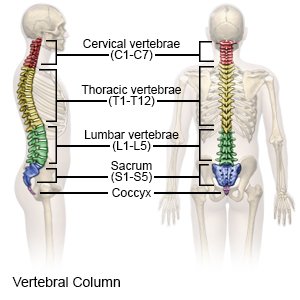Cervical Facet Block
Medically reviewed by Drugs.com. Last updated on Apr 6, 2025.
A cervical facet block is a procedure to inject medicine at the facet joints in your cervical (neck) spine. Facet joints are found at the back of each vertebrae.
 |
DISCHARGE INSTRUCTIONS:
Call your local emergency number (911 in the US) if:
- You have trouble breathing or chest pain.
Call your doctor if:
- You have pain in your neck, shoulder, or arm that does not go away or gets worse.
- Parts of your body are numb, tingly, cool to the touch, or look blue or pale.
- You have a fever.
- You have chills, a cough, or feel weak and achy.
- Your skin is itchy, swollen, or has a rash.
- You have a headache that does not go away, even after you take medicine.
- You have nausea or vomiting.
- You have questions or concerns about your condition or care.
Drugs used to treat this and similar conditions
Tylenol
Tylenol is a pain reliever and a fever reducer used to treat many conditions such as headaches ...
Dilaudid
Dilaudid (hydromorphone) is a narcotic pain reliever used to treat moderate to severe pain ...
Ozempic
Learn about Ozempic (semaglutide) for type 2 diabetes treatment, weight management, cardiovascular ...
Qutenza
Qutenza patches are used to treat neuropathic pain associated with postherpetic neuralgia and ...
OxyContin
OxyContin (oxycodone) is an opioid pain reliever used to treat moderate to severe pain. Includes ...
Percocet
Percocet (acetaminophen and oxycodone) is used to relieve moderate to severe pain. Includes ...
Acetaminophen/hydrocodone
The combination of hydrocodone and acetaminophen is used to relieve moderate to severe pain ...
Hydrocodone
Hydrocodone (Hysingla ER and Zohydro ER) is used for around-the-clock treatment of severe pain ...
Oxycodone
Oxycodone is an opioid analgesic used to treat moderate to severe pain; it has a high potential for ...
Acetaminophen
Acetaminophen is a widely used pain reliever and fever reducer for conditions like headaches ...
Medicines:
You may need any of the following:
- Antibiotics prevent or fight an infection caused by bacteria.
- Prescription pain medicine may be given. Ask your healthcare provider how to take this medicine safely. Some prescription pain medicines contain acetaminophen. Do not take other medicines that contain acetaminophen without talking to your healthcare provider. Too much acetaminophen may cause liver damage. Prescription pain medicine may cause constipation. Ask your healthcare provider how to prevent or treat constipation.
- Take your medicine as directed. Contact your healthcare provider if you think your medicine is not helping or if you have side effects. Tell your provider if you are allergic to any medicine. Keep a list of the medicines, vitamins, and herbs you take. Include the amounts, and when and why you take them. Bring the list or the pill bottles to follow-up visits. Carry your medicine list with you in case of an emergency.
Self-care:
Your healthcare provider will tell you when you can take pain medicine after the procedure. The following can help manage pain from your medical condition or from the procedure:
- Apply ice to the injection site. Ice can help relieve pain or swelling caused by the injection. Use an ice pack, or put crushed ice in a plastic bag. Wrap a towel around the bag before you apply it to your skin.
- Return to your regular activities as directed. Your provider will give you specific instructions for activity after this procedure. He or she will tell you when it is okay to drive and do other activities.
- Go to physical therapy if directed. A physical therapist teaches you exercises to help improve movement and strength, and to decrease pain.
- Keep a record of your pain. Write down when you have pain. Include how severe it is and if anything makes it better or worse. Bring the record to follow-up visits.
Follow up with your doctor as directed:
Write down your questions so you remember to ask them during your visits.
© Copyright Merative 2025 Information is for End User's use only and may not be sold, redistributed or otherwise used for commercial purposes.
The above information is an educational aid only. It is not intended as medical advice for individual conditions or treatments. Talk to your doctor, nurse or pharmacist before following any medical regimen to see if it is safe and effective for you.
Further information
Always consult your healthcare provider to ensure the information displayed on this page applies to your personal circumstances.
